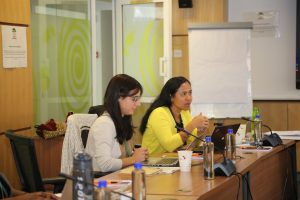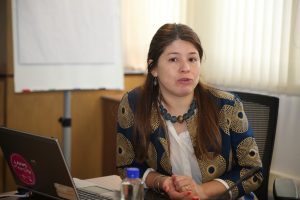The unprecedented and accelerating loss of biodiversity is one of the greatest crises of our time. Biodiversity is the invisible infrastructure that supports the healthy functioning of our food systems, economies and communities—and it’s deteriorating at an alarming rate: 1 million animal and plant species are now threatened with extinction.
The loss of biodiversity affects us all, but pervasive gender inequalities and differentiated gender norms mean that men and women experience the impacts of biodiversity loss differently. Parties to the Convention on Biological Diversity (CBD), in recognition of this disparity, have committed to integrating gender considerations into the post-2020 global biodiversity framework.
An Open-Ended Intersessional Working Group is charged with the development of a new framework and strategic plan that will replace the existing Strategic Plan for Biodiversity when it lapses in 2020. The first meeting of the Working Group was held at the UN Environment headquarters in Nairobi on 27-30 August 2019.

Prior to the event, select participants met at the World Agroforestry (ICRAF) campus for a full-day technical discussion to build consensus around the key elements of the new gender-responsive framework. The workshop, organized by UN Women and the CGIAR Research Program on Forests, Trees and Agroforestry (FTA), was attended by 12 representatives from national governments, civil society organizations and movements, UN agencies and other international organizations.
The workshop featured two initial presentations by Verona Collantes, Intergovernmental Specialist at UN Women, and Ana Maria Paez Valencia, ICRAF’s Social Scientist and Gender Specialist. They touched on the gender dimensions of biodiversity management and the process of integrating these considerations into the post-2020 global biodiversity framework.
Following the presentations, the hosts led a discussion that focused on defining the gender considerations that needed to be reflected and considered in the post-2020 biodiversity framework in terms of goals, targets and indicators, accountability mechanisms, enabling conditions and capacities.
“Waiting until there is an established structure on gender won’t work. We have the opportunity to brainstorm key messages and ideas that could be brought to attention during the upcoming discussion to engage the Working Group, and ensure the meaningful integration of gender considerations into the new framework from the start.” Verona Collantes Intergovernmental Specialist at UN Women
The discussion led to a consensus on several key messages that were presented to the Open-Ended Intersessional Working Group at the First Meeting. These key messages are summarized below.
The post-2020 global biodiversity framework must be underpinned by gender-responsive goals, targets and indicators.
Participants reviewed and discussed possible options for targets and indicators for measuring the level of gender responsiveness within the new biodiversity framework. It was agreed that specific gender-related indicators should be mainstreamed across all sets of thematic targets, in addition to the inclusion of a target that is particularly centred around gender equality:
“By 2030, governments and other relevant stakeholders (academia, private sector, international organizations and implementing entities, etc.) have put in place instruments and mechanisms to ensure, monitor and report on: i) women and girls’ engagement in decision-making in biodiversity conservation and sustainable use; ii) fair and equitable sharing of benefits from the utilization of genetic resources; and iii) differential impacts of biodiversity loss.”
Participants emphasized the need to develop gender-specific indicators that align with the Sustainable Development Goal (SDG) indicators and with the three objectives of the CBD. Gender-disaggregated data collection and reporting within the framework will allow for more responsive adaptive learning throughout implementation.
There is a need to strengthen accountability when it comes to integrating gender considerations in the CBD process. 1
During the CBD’s 14th Meeting of the Conference of the Parties (CBD COP14), all Parties agreed to the decisions from COP14, which referenced guidelines for the development of gender-responsive post-2020 biodiversity framework and included the approval of a Gender Action Plan (GAP). Participants of the workshop agreed that because this was an official COP decision, it should be used as a starting point for holding Parties accountable.

The workshop discussed possible mechanisms such as including gender responsiveness, or progress on gender relevant indicators as part of the voluntary peer-review process that assesses the development and implementation of national biodiversity strategies and action plans (NBSAPs).
The inclusion of gender-responsive indicators for each target within the new framework should be linked to data collection and reporting mechanisms, with requirements for the inclusion of sex-disaggregated data and gender considerations in reporting templates. Moreover, participants agreed that compliance mechanisms should be facilitative, meaning that Parties who are unable or need support in implementing monitoring requirements will receive training and support.
An enabling environment is essential for mainstreaming gender considerations into the post-2020 framework.
Fundamental to the success of the post-2020 framework is the availability of sustained finance for implementation. Workshop participants underscored the importance of earmarking financial flows for gender-responsive activities and, specifically, for implementation of the CBD’s Gender Action Plan. They agreed that the plan should be revised to reflect updates within the post-2020 framework. If equipped with meaningful requirements for monitoring and reporting, the revised Gender Action Plan has the potential to become a powerful tool to guide action and hold Parties accountable.
The workshop also underscored the importance of capacity building and funding for the development of appropriate methodologies and approaches for the integration of gender considerations into relevant policy, strategy, and monitoring and evaluation frameworks. The need for capacity building applies not only to CBD processes and strategies, but to broader governmental directives, policies and strategic plans on biodiversity, at all levels of governance and implementation.
Originally published at World Agroforestry (ICRAF).
——–
World Agroforestry (ICRAF) is a centre of scientific and development excellence that harnesses the benefits of trees for people and the environment. Knowledge produced by ICRAF enables governments, development agencies and farmers to utilize the power of trees to make farming and livelihoods more environmentally, socially and economically sustainable at multiple scales.











